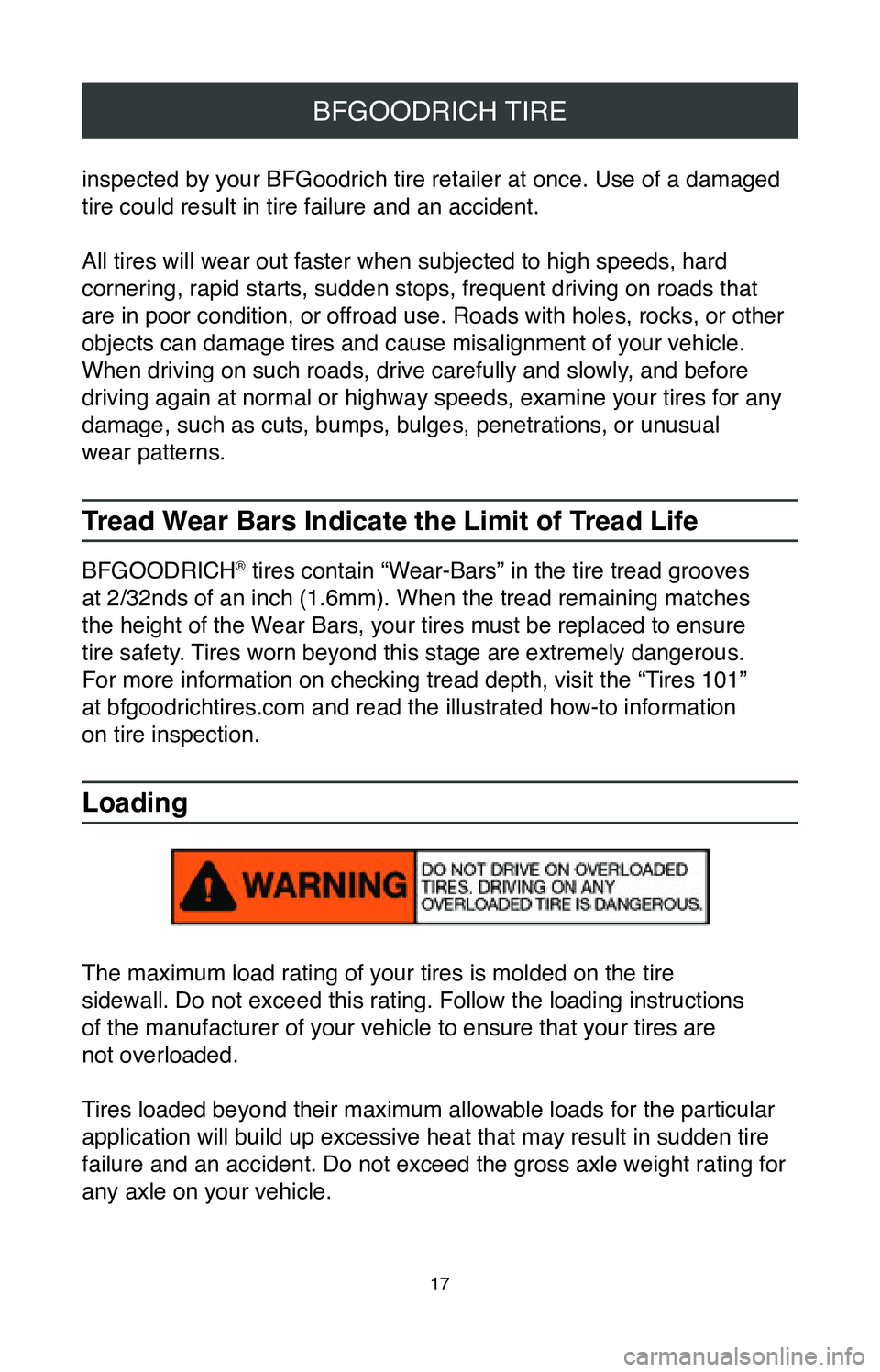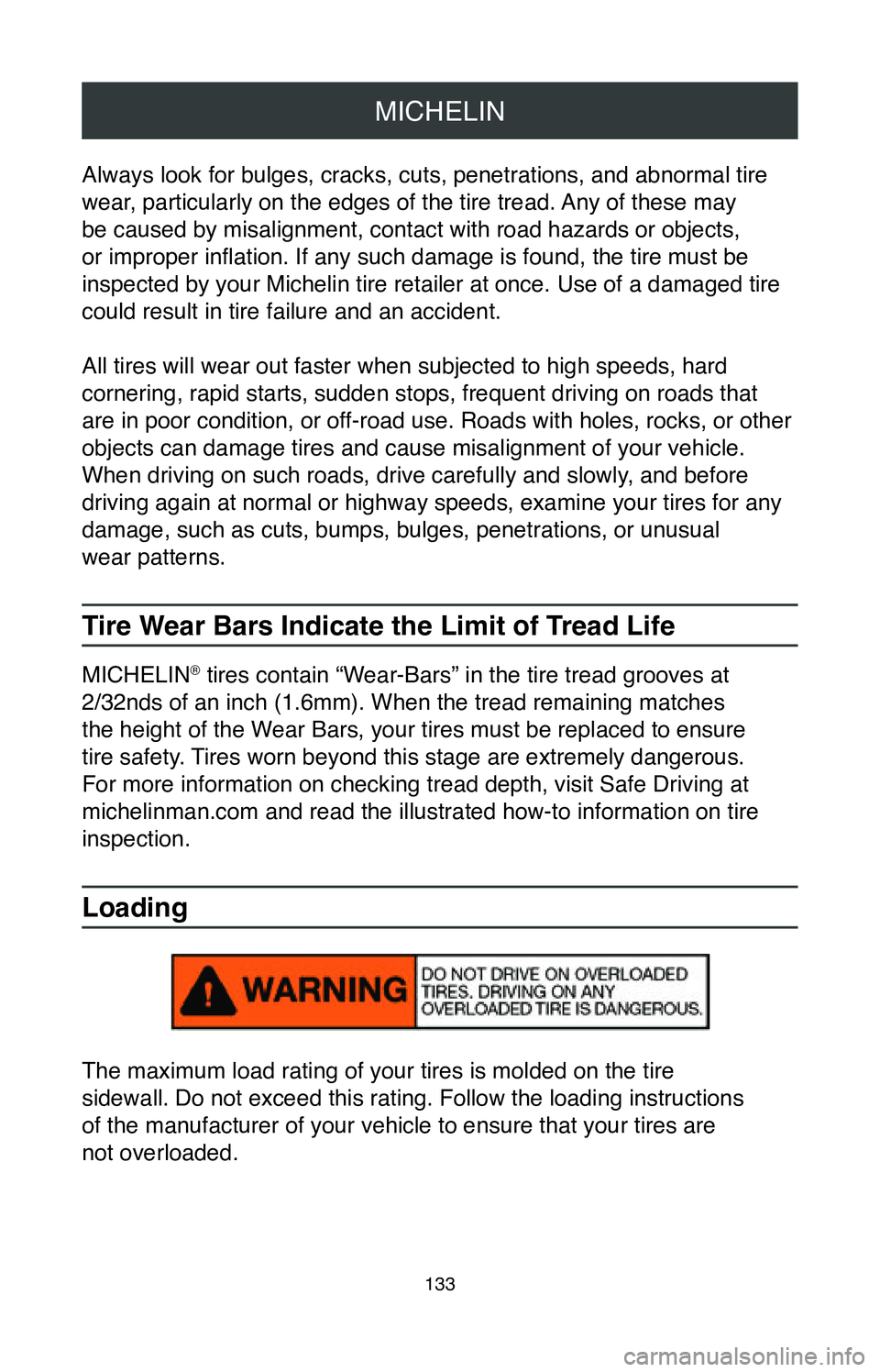stop start TOYOTA COROLLA HATCHBACK 2020 Warranties & Maintenance Guides (in English)
[x] Cancel search | Manufacturer: TOYOTA, Model Year: 2020, Model line: COROLLA HATCHBACK, Model: TOYOTA COROLLA HATCHBACK 2020Pages: 260, PDF Size: 8.54 MB
Page 19 of 260

17
BFGOODRICH TIRE
inspected by your BFGoodrich tire retailer at once. Use of a damaged
tire could result in tire failure and an accident.
All tires will wear out faster when subjected to high speeds, hard
cornering, rapid starts, sudden stops, frequent driving on roads that
are in poor condition, or offroad use. Roads with holes, rocks, or other
objects can damage tires and cause misalignment of your vehicle.
When driving on such roads, drive carefully and slowly, and before
driving again at normal or highway speeds, examine your tires for any
damage, such as cuts, bumps, bulges, penetrations, or unusual
wear patterns.
Tread Wear Bars Indicate the Limit of Tread Life
BFGOODRICH® tires contain “Wear-Bars” in the tire tread grooves
at 2/32nds of an inch (1.6mm). When the tread remaining matches
the height of the Wear Bars, your tires must be replaced to ensure
tire safety. Tires worn beyond this stage are extremely dangerous.
For more information on checking tread depth, visit the “Tires 101”
at bfgoodrichtires.com and read the illustrated how-to information
on tire inspection.
Loading
The maximum load rating of your tires is molded on the tire
sidewall. Do not exceed this rating. Follow the loading instructions
of the manufacturer of your vehicle to ensure that your tires are
not overloaded.
Tires loaded beyond their maximum allowable loads for the particular
application will build up excessive heat that may result in sudden tire \
failure and an accident. Do not exceed the gross axle weight rating for \
any axle on your vehicle.
Page 108 of 260

KENDA
106
must be inspected by any tire dealer at once. Use of a damaged tire
could result in sudden tire destruction.
All tires will wear out faster when subjected to high speeds as well as
hard cornering, rapid starts, sudden stops, frequent driving on roads
which are in poor condition, and off road use. Roads with holes and
rocks or other objects can damage tires and cause misalignment of
your vehicle. When you drive on such roads, drive on them carefully
and slowly, and before driving at normal or highway speeds, examine
your tires for any damage, such as cuts or penetrations.
Worn Out Tires Are Dangerous
Tires contain ‘Wear-Bars” in the grooves of the tire tread which show
up when only 2/32nds of an inch (1.6mm) tread is remaining. At this
stage, your tires must be replaced. Tires worn beyond this stage
are dangerous.
Do Not Overload
Driving On Any Overloaded Tire Is Dangerous
The maximum load rating of your tires is marked on the tire sidewall.
Do not exceed these ratings. Follow the loading instructions of the
manufacturer of your vehicle and this will insure that your tires are no\
t
overloaded. Tires which are loaded beyond their maximum allowable
loads for the particular application will build up excessive heat that m\
ay
result in sudden tire destruction.
Do not exceed the gross axle weight ratings for any axle on your
vehicle. TRAILER TOWING
If you anticipate towing a trailer, you should see any tire dealer for
advice concerning the correct size of tire and pressures. Tire size
and pressures will depend upon the type and size of trailer and hitch
utilized, but in no case must the maximum cold inflation pressure of
tire load rating be exceeded. Check the tire placard and the owner’s
manual supplied by the manufacturer of your vehicle for further
recommendations on trailer towing.
Page 135 of 260

MICHELIN
133
Always look for bulges, cracks, cuts, penetrations, and abnormal tire
wear, particularly on the edges of the tire tread. Any of these may
be caused by misalignment, contact with road hazards or objects,
or improper inflation. If any such damage is found, the tire must be
inspected by your Michelin tire retailer at once. Use of a damaged tire \
could result in tire failure and an accident.
All tires will wear out faster when subjected to high speeds, hard
cornering, rapid starts, sudden stops, frequent driving on roads that
are in poor condition, or off-road use. Roads with holes, rocks, or other
objects can damage tires and cause misalignment of your vehicle.
When driving on such roads, drive carefully and slowly, and before
driving again at normal or highway speeds, examine your tires for any
damage, such as cuts, bumps, bulges, penetrations, or unusual
wear patterns.
Tire Wear Bars Indicate the Limit of Tread Life
MICHELIN® tires contain “Wear-Bars” in the tire tread grooves at
2/32nds of an inch (1.6mm). When the tread remaining matches
the height of the Wear Bars, your tires must be replaced to ensure
tire safety. Tires worn beyond this stage are extremely dangerous.
For more information on checking tread depth, visit Safe Driving at
michelinman.com and read the illustrated how-to information on tire
inspection.
Loading
The maximum load rating of your tires is molded on the tire
sidewall. Do not exceed this rating. Follow the loading instructions
of the manufacturer of your vehicle to ensure that your tires are
not overloaded.